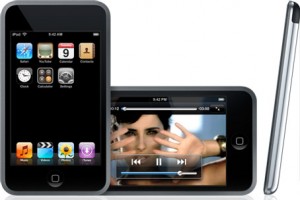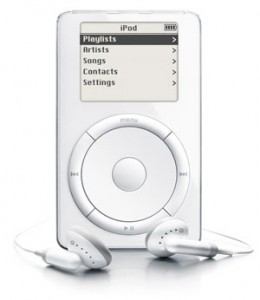 The iPod will undoubtedly go down in history as an iconic device, and forever be tied to the astonishing success Apple has enjoyed over the last decade, but it’s also been in decline in the last few years. Is it slowly fading away into the history books, or has it just evolved into other devices and services we’re already taking for granted?
The iPod will undoubtedly go down in history as an iconic device, and forever be tied to the astonishing success Apple has enjoyed over the last decade, but it’s also been in decline in the last few years. Is it slowly fading away into the history books, or has it just evolved into other devices and services we’re already taking for granted?
The question is worth noting as we get closer to the 10-year anniversary of Apple’s darling portable media player. On October 23, 2001, Steve Jobs unveiled the iPod in a keynote address that bore no resemblance to the grandeur that followed years later when he stunned audiences with the likes of the iPhone, MacBook Air and iPad.
At the time, the iPod had a 5GB hard drive that put “1,000 songs in your  pocket”. It didn’t have the vaunted touch scroll wheel, there was no colour screen and iTunes didn’t have a music store. In fact, it wasn’t even the first MP3 player to come to market, either, but it came with a perfect storm.
pocket”. It didn’t have the vaunted touch scroll wheel, there was no colour screen and iTunes didn’t have a music store. In fact, it wasn’t even the first MP3 player to come to market, either, but it came with a perfect storm.
It supported different file formats, aside from MP3s, that competing products didn’t necessarily bother with. It had a close connection with iTunes, making it easy to sync music to and from the device. And with the introduction of the iTunes Music Store in 2003, the iPod and iTunes put music retailers and their stacks of CDs on notice. Plus, it looked cool and the messaging behind the product resonated with consumers.
It miniaturized entire collections of music and made them portable, only to repeat the same feat with photos. It made it easy to watch video on a smaller screen. The iPod touch, coupled with the App Store, made it a slick casual gaming device, something Apple campaigned on for a solid year.
There’s no disputing the scope of what the iPod has done. Apple has sold over 300 million of them in a decade, trouncing all other comers combined several times over. But its sales have been on a steady decline going back to 2006. Though fourth quarter results aren’t expected until October or November (Apple’s fiscal year starts in October and ends in September), the last three quarters saw a combined 44 percent decline in overall iPod sales from the same three-quarter period the year before.
To be clear, Apple currently defines its iPod category as encompassing the iPod touch, iPod nano and iPod shuffle. But the company doesn’t publicly disclose the sales breakdown of the line, so it’s not known how well each one performed in the market.
What is known is that, despite the sharp decline, Apple still sold 36 million iPods over that span. And that’s not even including the fourth quarter, which will likely see another drop, albeit with millions more sold.
 Can a product line that sells this well even be considered to be ‘dying’ at all? Perhaps the answer lies in what Steve Jobs said when he unveiled the iPhone in 2007. “It’s the best iPod we’ve ever made,” he noted at the time. And it turns out that he was right. The iPhone now outsells the iPod line combined, and third-quarter results also saw the iPad outsell the iPod line as well.
Can a product line that sells this well even be considered to be ‘dying’ at all? Perhaps the answer lies in what Steve Jobs said when he unveiled the iPhone in 2007. “It’s the best iPod we’ve ever made,” he noted at the time. And it turns out that he was right. The iPhone now outsells the iPod line combined, and third-quarter results also saw the iPad outsell the iPod line as well.
Though I never actually wrote it, I had suggested two years ago that Apple should have dropped the iPod Classic earlier, and dumped either the nano or the shuffle (I was leaning towards the nano at the time). The touch is too good a device to stop making because it’s an entry point to Apple’s product line — a taste of what iOS is capable of and how the elegance of design and functionality that Apple espouses comes together.
The nano can’t showcase iOS in the same way, and the shuffle doesn’t even have a screen. Both are popular with the gym and jogging crowd, but does it make sense to keep them both going? The nano will surely drop in price to under $100 in its next iteration, squeezing the shuffle even more.
Even if Apple were to kill off all of the iPods tomorrow, the iPod would still survive in the forms we take for granted. The music stored on an iPhone or iPad can be found in the iPod app. What iTunes has become is largely the result of what the iPod enabled it to do. The accessories and aftermarket gizmos that were designed to accommodate iOS devices exist because the iPod gave life to that aftermarket.
In short, the decline may be financial, but the value of the device to Apple’s fortunes has already proven itself in spades, and looks to continue doing so. The iPod proved that consumers would be willing to spend more on devices they felt looked cool and offered user-friendly interaction. It led the way for the iPhone and iPad to resonate with people the same way.
It won’t dominate the stage like it once did years ago, but that was probably the point, since it was just setting the stage for so much else.



